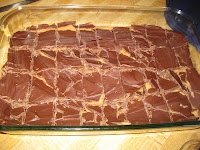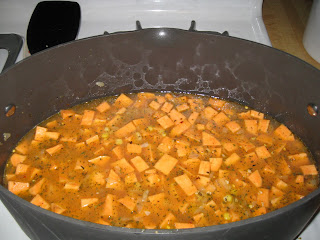So – back to the cooking – I’ve cooked several dishes in my deep covered baker, and I hate to break the news to my husband, but I’ve fallen in love. I prepared a very hearty Rosemary and Chicken Soup as well as an All-American Pot Roast. Now I already have a pot roast recipe. My mom gave it to me, and it’s her interpretation of the recipe that my grandmother gave to her. It’s mouth-watering. The only problem is that it bakes for about 4 hours, so there is no way that this can be a weeknight dish. The Pampered Chef’s All-American Pot Roast only bakes for a couple of hours and has such a different flavor – incorporating wine and tomato paste in the sauce – that I have added it to my repertoire… by no means replacing my all-time favorite and now to be saved for weekends family recipe.
 I used my rectangle bar stone 4 times this weekend… almost with every dish I made! The best part was how easy it was to wash off with just water and a washcloth. I used it to make some toasted baguette slices to use as dippers for a pizza dip on Saturday. On Sunday I used it to make a jelly roll, I used it for a cheesy artichoke appetizer, and I used it to baked some breaded chicken.
I used my rectangle bar stone 4 times this weekend… almost with every dish I made! The best part was how easy it was to wash off with just water and a washcloth. I used it to make some toasted baguette slices to use as dippers for a pizza dip on Saturday. On Sunday I used it to make a jelly roll, I used it for a cheesy artichoke appetizer, and I used it to baked some breaded chicken. When I saw the jelly roll recipe, I tensed up. I like to bake… love it, even… but I have not had the best luck actually manipulating the cakes. I once volunteered to make two cakes for a surprise 30th birthday party for a family member. What was I thinking?? To add the icing on the cake (pun absolutely intended… I couldn’t help myself), it was in New Orleans – an hour from where I live. My mother had already warned me: cakes don’t travel well. They crack. But I thought I’d give it a go anyway.
 What happened?? I mean, do I even have to say it? The cake starting cracking on the way, the icing slowly falling away from the cake, tears falling down my cheeks. (I know. I cry… Ask my husband about the time I tried to learn to drive a standard... Or ask my mother about the time I tried to paint. I like to succeed. What can I say?) So when I came upon the Cherry Almond Angel Roll recipe… the butterflies that fluttered in my stomach were even growling. I had no choice. Much to my surprise – and relief – the directions were perfectly written, and the products yielded perfect results. No cracking or crumbling to be seen.
What happened?? I mean, do I even have to say it? The cake starting cracking on the way, the icing slowly falling away from the cake, tears falling down my cheeks. (I know. I cry… Ask my husband about the time I tried to learn to drive a standard... Or ask my mother about the time I tried to paint. I like to succeed. What can I say?) So when I came upon the Cherry Almond Angel Roll recipe… the butterflies that fluttered in my stomach were even growling. I had no choice. Much to my surprise – and relief – the directions were perfectly written, and the products yielded perfect results. No cracking or crumbling to be seen.Not only was it easy to do, but it looks very impressive to dinner guests when it’s complete. So, to all my stone owners, try it out! And if you don’t have one yet, this recipe is a fabulous reason to get one! If you want to impress your dinner guests or learn more about all the remarkable products by The Pampered Chef and how to get them FOR FREE (no really... did you not see the picture at the top of this post??) just let me know (eliseleboeufTPC@gmail.com).
Cherry-Almond Angel Roll
[From All the Best by The Pampered Chef]
Ingredients:
1 pkg (16 oz or 430-450 g) angel food cake mix
1/2 cup (125 mL) sliced almonds, chopped
1/2 cup (125 mL) powdered or icing sugar
1/2 cup (125 mL) cherry preserves
1 cup (250 mL) sour cream
4 cups (1 L) thawed, frozen whipped topping
1/2 tsp (2 mL) almond extract
2-4 drops red food coloring (optional)
1 pkg (3.3 oz or 102 g) white chocolate or vanilla instant pudding and pie filling
Directions:
1.Preheat oven to 350°F (180°C). Line Large Bar Pan with an 18-in. (45-cm) piece of Parchment Paper. Prepare cake mix according to package directions. Pour batter over parchment, spreading evenly. Sprinkle almonds evenly over batter. Bake 30-35 minutes or until top springs back when lightly touched with fingertip. Remove pan from oven.
2.Sprinkle sugar over cake. Place an additional piece of parchment over cake. Invert Stackable Cooling Rack over parchment. Carefully invert cake; remove pan and parchment from bottom of cake. Starting at short side, roll up cake in parchment, jelly-roll style. Cool completely.
3.Unroll cake and spread with preserves. In large bowl, combine sour cream, whipped topping, almond extract and food coloring, if desired; mix well. Add pudding mix; whisk until thickened. Spread filling over cake to within 1 in. (2.5 cm) of edge; roll up cake. Refrigerate at least 30 minutes.















































